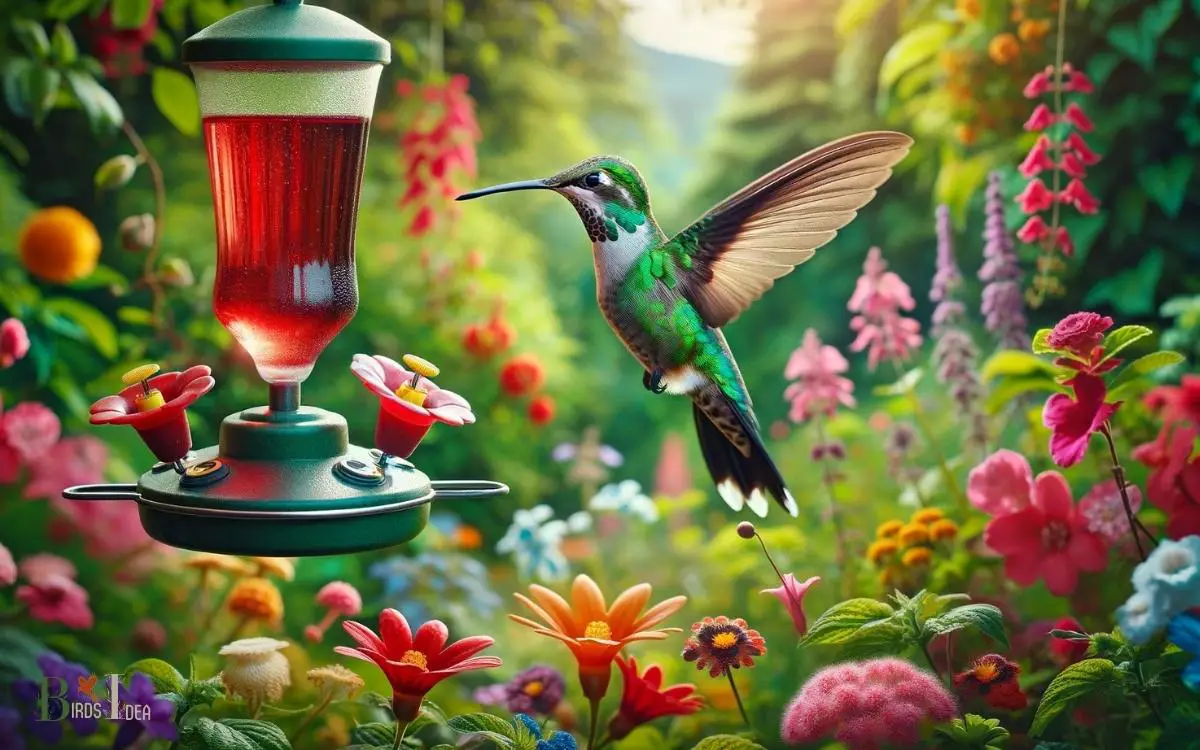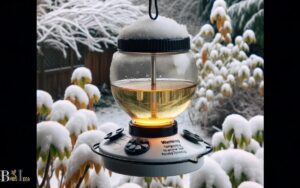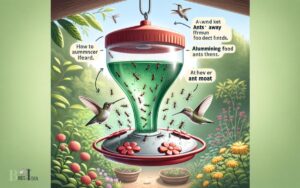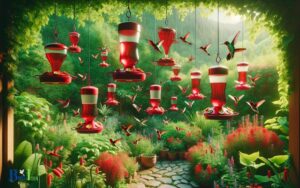Hummingbird Nectar Red vs Clear: Discover The Differences!
When choosing nectar for hummingbird feeders, it’s important to understand the differences between red and clear nectar.
Red nectar has traditionally been used to attract hummingbirds due to their attraction to the color red.
However, clear nectar is often recommended by experts as it is free from artificial coloring and closer to the natural nectar found in flowers.
Hummingbirds are indeed drawn to the color red, but this preference is best utilized in the feeder design rather than the nectar itself.
Here’s why:
Choose clear nectar for a safe and natural option to keep hummingbirds healthy and coming back to your feeders.

Key Takeaway
Hummingbird Vision and Color Perception
In considering hummingbird vision and color perception, it is essential to understand how these tiny birds perceive and distinguish colors in their environment.
Hummingbirds have excellent color vision, with a strong sensitivity to red, orange, and pink hues, which are often associated with their preferred nectar sources.
They are attracted to vibrant and brightly colored flowers, as these stand out against the green foliage and are easily distinguishable to the birds.
This heightened color perception plays a crucial role in their foraging behavior, guiding them to the most rewarding nectar sources.
Understanding their visual capabilities and color preferences is vital in creating an environment that supports and attracts these remarkable creatures. This leads us to the subsequent section about their attraction and feeding preferences.
Attraction and Feeding Preferences
Understanding the visual capabilities and color preferences of hummingbirds is crucial for comprehending their attraction and feeding preferences.
Hummingbirds are attracted to bright, vibrant colors, especially red, as it signals a potential food source.
Their color vision extends into the ultraviolet spectrum, allowing them to see a wide range of colors that humans cannot perceive.
When it comes to feeding preferences, hummingbirds are primarily drawn to flowers with tubular shapes, which are often brightly colored to attract them.
They are also known to favor nectar with a higher sugar content, as it provides them with the energy they need for their rapid metabolism.
By understanding these preferences, individuals can effectively attract and serve hummingbirds with the appropriate nectar and feeders, contributing to their well-being and survival.
Impact of Nectar Color on Behavior
Hummingbirds’ behavioral responses to nectar color play a crucial role in their foraging and feeding patterns, influencing their overall well-being and survival.
The impact of nectar color on hummingbird behavior is significant and can affect their visitation to feeders and flowers.
The following table illustrates the behavioral responses of hummingbirds to different nectar colors:
| Nectar Color | Behavioral Response |
|---|---|
| Red | Attracted and feeds |
| Clear | Less attracted |
| Other colors | Variable response |
Understanding these behavioral responses is essential for serving hummingbirds effectively. By providing nectar in colors that align with their preferences, we can support their feeding habits and contribute to their well-being.
Transitioning into the subsequent section about ‘environmental and feeder considerations’, it is crucial to consider the impact of nectar color on hummingbird behavior when designing feeding stations and selecting nectar for these remarkable birds.
Red Hummingbird Nectar
Pros and Cons of Red Hummingbird Nectar
Pros:
- Attractiveness to Hummingbirds: Red is a color that naturally attracts hummingbirds, mimicking the hues of many flowers they feed on.
- Enhanced Visibility: Red nectar is easily visible to hummingbirds, facilitating their identification of food sources.
- Increased Feeding Activity: Studies suggest that red nectar can stimulate higher feeding activity among hummingbirds.
Cons:
- Artificial Dyes and Additives: Many commercially available red nectars contain artificial dyes that may be harmful to hummingbirds.
- Potential Misleading Signals: Overuse of red nectar may create artificial signals, leading hummingbirds away from essential natural sources.
- Expense and Availability: Quality red nectar may be more expensive or less readily available than other alternatives.
Common Misconceptions Regarding Red Hummingbird Nectar
- All Reds Are Equal: Misconception that any red-colored nectar will attract hummingbirds, ignoring variations in shades and tones.
- Exclusive Preference: Assumption that hummingbirds exclusively prefer red, overlooking their adaptive feeding habits across various colors.
- Healthier for Hummingbirds: Misbelief that red nectar is inherently healthier, ignoring potential harm from artificial additives.
Understanding both the advantages and drawbacks of red hummingbird nectar is crucial for creating a safe and appealing environment for these vibrant birds.
Clear Hummingbird Nectar
Advantages and Disadvantages of Clear Hummingbird Nectar
Advantages:
- Natural Appearance: Clear nectar closely resembles the natural color of flower nectar, providing an authentic feeding experience.
- No Artificial Additives: Clear nectar formulations often avoid artificial dyes, reducing the risk of potential harm to hummingbirds.
- Versatility: Clear nectar can be used in various feeders without the risk of staining or discoloration.
Disadvantages:
- Lower Attraction for Some Species: Certain hummingbird species may be less attracted to clear nectar, impacting feeder utilization.
- Visibility Challenges: Clear nectar might be less visible in certain lighting conditions, potentially making it harder for hummingbirds to locate.
- Misperceived as Water: Hummingbirds may mistake clear nectar for water, affecting feeding patterns and nutritional intake.
Scientific Considerations for Clear Hummingbird Nectar
- Natural Sucrose Concentration: Mimics the natural sucrose concentration found in many flowers, aligning with the hummingbirds’ dietary needs.
- UV Reflectance: Clear nectar may exhibit UV reflectance, which is visible to hummingbirds, aiding in attracting them.
- Research on Species Preferences: Scientific studies explore the preferences of different hummingbird species towards clear nectar, contributing to feeder optimization.
Understanding the nuances of clear hummingbird nectar, both in terms of its advantages and potential drawbacks, allows for informed choices in maintaining a hummingbird-friendly environment.
Nectar Color Myths Debunked
Debunking nectar color myths is crucial for understanding hummingbird feeding preferences and behaviors.
Many misconceptions surround the ideal color of hummingbird nectar, but it’s essential to dispel these myths to better serve these magnificent creatures.
- The truth is that hummingbirds are attracted to the color red due to their keen ability to spot bright hues, but they are also drawn to clear nectar.
- Understanding this allows us to cater to a wider range of hummingbird species and individuals, ensuring that all can partake in the nectar we provide.
- By debunking these myths, we can better serve the diverse needs of hummingbirds, fostering a more inclusive and welcoming environment for these remarkable birds.
- Ultimately, our efforts to dispel nectar color myths enable us to provide the best possible care for hummingbirds, enhancing their overall well-being and enjoyment.
Should I Use Red or Clear Nectar for Hummingbirds if I Want to Serve it Warm?
If you want to serve warm nectar for hummingbirds, it is recommended to use clear nectar instead of red. While red attracts hummingbirds, heating the nectar may cause red dyes to lose their vibrant color. Clear nectar heated to the desired temperature will still be appealing and provide the required warmth for these delightful creatures.
Best Practices for Nectar Color
Understanding the importance of providing a variety of nectar colors is essential for accommodating the diverse preferences of hummingbird species.
While it is a common misconception that only red nectar attracts hummingbirds, the truth is that these birds are attracted to a range of colors, including clear nectar.
To ensure that you are catering to the needs of a broad spectrum of hummingbird species, it is best to offer nectar in both red and clear variations.
This approach aligns with the goal of serving these remarkable birds and supporting their well-being.
By offering a variety of nectar colors, you can help ensure that all hummingbird species visiting your feeders have access to a suitable nectar option, contributing to their overall health and vitality.
Conclusion
The color of hummingbird nectar can impact their behavior and feeding preferences. Understanding their vision and color perception is essential for creating an attractive and accessible feeding environment.
Debunking myths about nectar color and implementing best practices can help ensure the health and well-being of these fascinating birds.
Therefore, it is crucial to consider environmental factors and feeder design when choosing the color of hummingbird nectar.
Ultimately, creating an inviting and sustainable feeding environment benefits both the hummingbirds and the ecosystems they inhabit.






